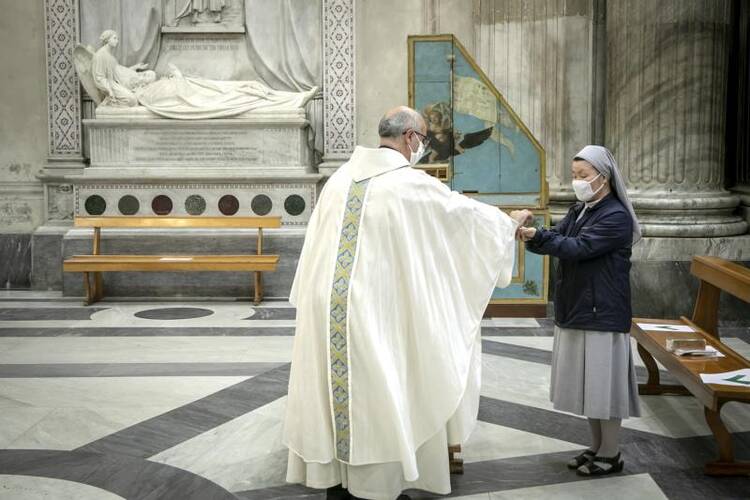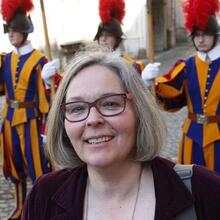VATICAN CITY (CNS) -- When Italy began allowing Masses with the faithful again, Pope Francis stopped livestreaming his early morning liturgy, encouraging people to return to Mass in person.
Three weeks later, at his Angelus address, he reminded Catholics that "it remains necessary to follow the rules in force carefully because they are rules that help us to prevent the virus from gaining ground" again.
The opportunity to return to Mass -- with restrictions -- since May 18, and the need for ongoing vigilance to control the COVID-19 pandemic have combined in Italy to create a situation in which some people rushed back to Mass and others were convinced it was too soon to be safe.
The fear factor naturally has a geographical component, looming larger in cities and towns that lost more of their people to the virus.
Msgr. Fabio Zucchelli, pastor of the cathedral in Bergamo -- the epicenter of Italy's contagion and death -- said the first Mass with a congregation "was a moment of joy," but there also was a nagging sense of "exhaustion, of feeling a bit lost because of the destruction, remembering all those who died and those who are still sick."
The province of Bergamo has a population of about 1.1 million people; as of June 9, the number of people who had contracted COVID-19 was 13,661 and 3,098 had died.
The government-imposed regulations for social distancing mean 160 people can attend each of the four Sunday Masses at the cathedral, Msgr. Zucchelli said June 10. "Up to now we have not reached the maximum."
"Certainly, it is clear there are fewer people at Mass, but everything here is starting slowly, slowly -- stores, restaurants, businesses," he said. "A pastor must have great patience, great respect for where people are and, at the same time, accompany them simply and serenely, showing them that all the health regulations are being respected and that life goes on."
Father Giorgio Giovanelli, pastor of St. Maria Goretti Parish in Fano, about 180 miles northeast of Rome, told Catholic News Service, "Just the joy of being together again was overwhelming" at the first Mass.
"It was like we'd been in a war and then people started coming out of the bunkers," he said. "There was a sense of, 'We did it. We made it.'"
Although two of the three Sunday Masses have reached the maximum of 150 people, "the community is divided between those who returned immediately and those who are afraid," he said. "Fear is legitimate and understandable," so he is livestreaming the parish Masses on Facebook.
Father Giovanelli's parents, who are in their 80s, live about 6 miles away, and he was overjoyed to be able to visit them when Italy began easing its strict lockdown. But they have not returned to Mass; "I told them to stay home for now."
One of his parishioners, Andrea Montalbini, did not see his parents for a month either -- and they live in an apartment in the same building. It was especially hard on Montalbini's two small children, "who were down there 10 times a day" before the pandemic.
His parents are 83 and 76, he said, "and it cost them a lot not being able to go to Mass," so when the faithful could attend again, his folks went. "The desire was stronger than the fear."
Even though "we have never gone two and a half months without going to Mass," Montalbini told CNS June 8 that he, his wife and children are not going back yet.
Italy's super-lockdown frightened the children, he said. After three months of trying to reassure them while convincing them the lockdown was necessary, "we cannot act now like it was nothing. We want to guide our children and show them that we still must be attentive."
As soon as Masses resumed, Valentina Sticca, another of Father Giovanelli's parishioners, put on a mask and latex gloves and walked to the church.
"The bells were ringing," she said. "I felt like I was going to Mass for the first time."
Fear of unknowingly spreading or catching the virus is still there, she said, "but it's there at the supermarket, too. We must live with it. We need to be prudent and responsible for ourselves and others, but we also need to show that we are a community."
Father Gianni Cioli, a professor and administrator of the small parish of San Giusto a Ema, near Florence, said his church building is so tiny that he has been celebrating Mass outside since May 18.
Still, with the social distancing required, a maximum of only 27 faithful can attend at one time. As of June 8, there had not been a Mass with all the seats full. The normal, pre-COVID attendance at each Sunday Mass in the small town was about 20 people, he said.
The Italian government has told people not to go to Mass if they have a fever or if, in the previous 14 days, they have interacted with someone with the coronavirus.
And the Archdiocese of Florence, like other Italian dioceses, Father Cioli said, has told the faithful they are not obliged to go to Mass if they are elderly, have a preexisting health condition or live with or take care of someone who is particularly vulnerable to the virus.
"But some elderly people have been coming," Father Cioli said.
The norms Italy put in place for Masses with a congregation include requiring all the faithful to wear a mask throughout the liturgy and obliging the celebrating priest to wear a mask and disposable gloves during the distribution of Communion.
"I was a bit unsure at first," Father Cioli told CNS. "I was afraid of doing something wrong with the mask and gloves, and I wanted to do everything possible to avoid contaminating anything."
Nichole Parker, a member of parish council at the U.S. parish in Rome, St. Patrick's, told CNS June 8 that she and her family continue to watch the parish Mass online. "It's not the same," she said, "but it just doesn't seem right to go back yet."
"We have a couple people in our family with compromised immunity, so we decided to wait," she said, adding that she was grateful to her pastor, Paulist Father Gregory S. Apparcel, for making it clear to parishioners that the decision is theirs.
With no tourists in town and with many people avoiding public transportation, St. Patrick's has not come close to reaching its government-approved capacity of 100 people, Father Apparcel said.
"Some people definitely do not feel comfortable" going to Mass in person yet, "and that's fine," Father Apparcel said. "It's interesting to me that we are to encourage the elderly, over 60 -- like me! -- not to come. Yet, I would say about 60% of our congregation these past three Sundays have been over 70. The older people especially feel that they have been welcomed home, and they wouldn't miss it."
Father Davide Carbonaro, pastor of Rome's parish of Santa Maria in Campitelli, said his first Mass back with a congregation was emotional because it was the fulfillment of "something I was longing for. A pastor without his parishioners -- obviously, something essential is missing."
"Even with all the restrictions, the distancing, the masks," he said, "just a glance, a nod, a bow allows us to establish a connection that is not simply human, but also spiritual."










